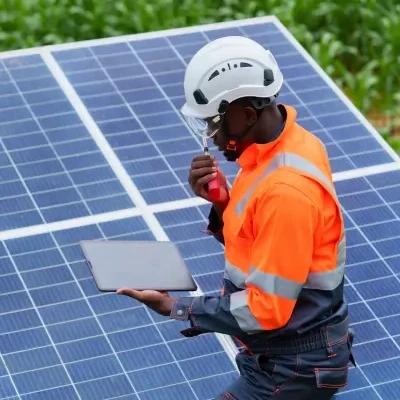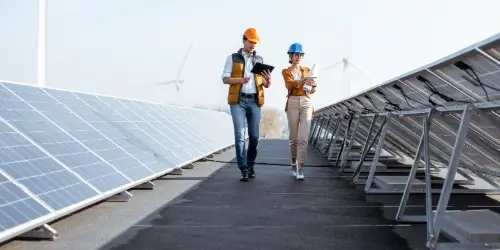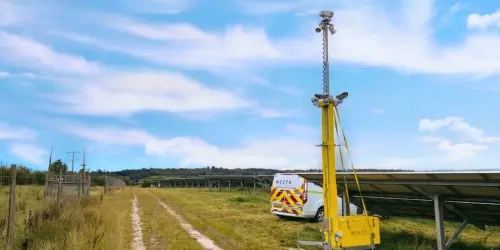Existing solar sites and those under construction are key to hitting the UK’s Net Zero target, cutting greenhouse gas emissions by 68% by 2030, and represent billions in investments.
But this growth has exposed the sector to escalating security threats, particularly copper cable theft, vandalism and trespassing. Without proper security measures in place, solar farms and development sites are easy targets for this criminal activity.
So, how do you protect your site and avoid costly losses? The solution lies in a well-thought-out solar farm security plan.
In this guide, we'll explain why solar sites require security, how to conduct comprehensive risk assessments and how to choose the right security solutions that address these concerns.
Why Solar Sites Need Comprehensive Security Planning
Both established solar farms and those under construction are subject to unique security threats that require specialised planning and solutions.
Here are 4 key reasons why solar security planning has become a business necessity:
- Valuable equipment: Solar panels, copper cabling, industrial-grade inverters and commercial battery storage units all have significant resale value on illicit markets. This value makes these items attractive targets for opportunistic thieves and organised crime groups. According to E.ON Energy, the average cost to build a solar farm is £1 million per megawatt (MW). This means a large 30 MW solar development would total around £30 million!
- Remote locations: Most solar farms and development sites are situated in isolated, rural areas with minimal surveillance. Their distance from populated areas means emergency response times are slower, giving criminals ample time to operate undetected.
- Operational disruptions: Even minor security breaches can impact clean energy generation. Losing just 10% capacity can result in thousands of pounds lost annually, while copper cable theft can lead to weeks of downtime during repairs. Additionally, operators may incur Power Purchase Agreement (PPA) penalties when energy targets are not met.
- Insurer requirements: Many insurance companies require specific security measures before providing coverage. Without proper surveillance, sites risk higher premiums, rejected claims or even no coverage at all.
Now that we've outlined why site security is important, let's explain how you can create an effective solar farm security plan. You can also visit our website to learn more about the real costs operators face when security measures fall short.
Step 1: Conduct a Proper Risk Assessment
Effective security planning starts with understanding your site's specific vulnerabilities. Each faces different risks based on its location, layout and operational factors.
Site-specific threat evaluation
Begin by mapping potential access routes and identifying vulnerable areas such as:
- Perimeter security analysis: Check fence lines, natural boundaries and potential access points.
- Asset zones: Document where high-value equipment is placed and stored. For instance, development sites might have concentrated volumes of solar panels or reels of copper cabling stored in open sheds or unsecured buildings.
- Site location: Solar farms near motorways may allow criminals to make quick getaways.
- Visibility assessment: Identify potential blind spots where criminals could operate undetected.
Geographical crime rates
Research historical crime patterns in your area:
- Contact the local authorities or police for crime statistics and analyses.
- Review insurance industry reports on renewable energy theft.
- Contact neighbouring solar farms for local insights.
Operational risk factors
Consider how your operations affect security:
- Construction phases: Uninstalled equipment can allow thieves to steal in bulk.
- Seasonal vulnerabilities: Consider weather conditions that could affect visibility, such as fog, heavy rain and snow.
- Staff access points: Check entrances and exits where staff gain access to your site.
Once you've mapped out these potential threats, you'll have a clearer picture of what security goals you want to achieve.
Step 2: Define Clear Security Goals & ROI
Successful solar farm security planning involves having a clear threat prevention strategy that aligns with your business priorities. Here’s how to define your objectives and calculate the financial benefits of investing in security:
Primary security objectives
Establish clear security goals for your critical infrastructure investments:
- Asset protection: Prevent theft, damage and unauthorised site access.
- Operational continuity: Minimise false alarms, generation losses and downtime.
- Evidence gathering: Establish adequate incident reporting for insurance claims.
- Physical deterrents: Create visible deterrents to discourage criminal activity.
- Compliance: Meet insurer, regulatory and ESG reporting requirements.
Return on investment (ROI)
When evaluating security solutions, consider both the direct costs of potential losses and the broader business impact of security failures. Calculate potential ROI on security installation investments using these factors:
- Asset replacement costs: Replacing equipment due to solar farm theft is expensive. Commercial-grade inverters (50 kW) can cost between £3,000 and £10,000 per unit to replace. Replacing 15 km of 4mm² copper cabling costs roughly £40,000.
- Revenue losses: 1 MW solar farms generating 4,000 kWh of green electricity daily can lose £2,000 for every 5 days they're offline (at a 10p/kWh rate) as a result of solar farm crime.
- Regulatory risks: Solar farm operators can face Power Purchase Agreement (PPA) penalties if green electricity targets are not adhered to.
- Higher premiums: Insurers may hike your insurance premiums (or reject cover) if proper solar farm protection is not in place.
- Professional security vs manned guarding: Professional security systems, like CCTV cameras with remote monitoring services, can potentially save operators 88% compared to security personnel.
Most solar projects offer a 10-20% return on investment, meaning security costs can often be recouped within 5 to 10 years. See our website for more information about calculating your solar site security ROI.
Step 3: Choosing the Right Security System & Provider
Choose a solar farm security system based on your risk assessment findings and operational requirements. Let's go over various security measures you can implement and briefly cover what to look for in a professional security provider.
Physical barriers
Strong physical deterrents can prevent unauthorised access:
- Security fencing: Secure, mesh welded perimeter fencing compliant with anti-intrusion standards secures your site against unwanted intrusions.
- Secure access control: Remote-controlled electric fences and pedestrian gates with PIN/key code access stop unauthorised visitors from entering your site.
- PID systems: Perimeter intrusion detection (PID) systems, like ANPR (automatic number plate recognition), detect intruders before crime escalates. PIDs work in low light and poor weather conditions to ensure day-to-night protection.
- Tamper-proof fixings: Strong padlocks, reinforced brackets and anti-tamper screws keep critical infrastructure safe and secure, making removal more difficult.
- Clear signage: Large, clear signboards indicating CCTV surveillance and restricted areas are desirable to prevent trespassers, vandals and squatters from gaining access to your site.
- Motion-sensor lights: Motion-triggered lights activate when movement is detected. These lighting units can integrate with advanced surveillance cameras to record footage of potential threats.
Advanced surveillance systems
Modern CCTV technology serves as both a physical deterrent and a live monitoring tool.
- Surveillance cameras: High-resolution 4K PTZ (Pan-Tilt-Zoom) CCTV cameras with thermal imagery and infrared (IR) night vision detect suspicious activity regardless of lighting or weather.
- Redeployable CCTV: Security systems should be movable units and easy to reposition. This is particularly beneficial for development sites where site layouts may change, covering new areas and preventing blind spots that criminals can exploit.
- AI-video analytics: Smart CCTV cameras with artificial intelligence functionality learn normal site patterns and trigger an immediate alarm when unusual behaviour is detected. They also differentiate between genuine threats (e.g., humans) versus false alarms (e.g., animals/wind).
- CCTV Towers: Designed for rapid deployment, these 6-metre, bright yellow towers provide near-360° site coverage without the need for fixed infrastructure or mains power.
- Temporary security solutions: Temporary CCTV solutions offer flexibility during construction phases or when site layouts change. These hired systems are designed specifically for off-grid solar farms and are available for as long as you need them.
Remote monitoring services
Fully-managed security systems linked to professional remote monitoring services ensure security breaches are promptly attended to without burdening you or your operations team:
- 24/7 surveillance: Remote monitoring assures trained security personnel at NSI Gold Accredited monitoring centres review your camera footage in real-time and initiate immediate action. This can include live audio warnings, dispatching keyholder teams or contacting the police.
- Mobile keyholding and alarm response: When a security threat is detected, mobile keyholding teams are dispatched to your site to investigate. Should emergency services be required, these security professionals initiate immediate action and provide operators with incident reports.
- In-built diagnostics: Fully-managed remote surveillance systems with in-built Heartbeat Software ensure your CCTV systems operate optimally. Automated system health checks run regularly to detect issues or faults.
What to look for in a security provider
The importance of a reliable security provider makes all the difference between preventing threats and falling victim to costly security breaches. Here are the key criteria to look for:
- Experience in solar farm security in remote locations.
- Proven track record of success in robust solar farm security solutions.
- Nationwide coverage to ensure quick installations, maintenance and support.
- Cost effectiveness with flexible rental options.
- Remote monitoring services with keyholding teams.
- Easy-to-use software for remote surveillance.
See why WCCTV is the UK's trusted security expert for solar farms and development sites.

Step 4: Implement Your Solar Farm Security Plan
Now it's time to put your security plan in place:
Phase 1: Asset protection
- Invest in high-quality perimeter security to secure boundaries and prevent unwanted access.
- Add controlled access points and signage.
- Install motion-sensor lights to illuminate blind spots.
- Integrate perimeter security with PID systems for full-spec site coverage.
Phase 2: Install CCTV
- Install CCTV cameras with HD, PTZ 4K cameras with thermal imaging and IR night vision.
- Link surveillance cameras to 24/7 remote monitoring services.
- Rent Temporary CCTV Towers during construction phases or in times of heightened crime.
Phase 3: Ensure compliance
- Ensure your security system meets environmental and regulatory compliance (e.g., Section 61).
- Go a step further: Invest in site condition monitoring sensors to prove ESG due diligence.
- Document security measures for all insurance policy requirements.
- Establish incident reporting procedures.
Now that you know why and how to implement your solar farm security plan, let's touch on why early implementation matters.
Why Early Security Installations at Solar Sites Matter
Proactive security measures are far better than reactive repairs and replacements. Here are the main reasons why:
- Cost-effective: Installing robust security systems protects valuable assets from thieves, vandals and squatters, preventing theft, damage and operational disruptions.
- Reduces vulnerabilities: The construction stage of solar farms is the most vulnerable due to the presence of unsecured, high-value assets.
- Compliance: Insurers are more likely to provide business coverage when security measures are in place.
- Protects ROI: Operational disruptions can severely impact a solar farm's profitability, leading to delayed ROI.
Ready to implement security solutions at your solar farm or development site? Reach out to WCCTV to discuss your needs today.
Get Started With WCCTV Today
A strong security plan is your solar farm’s best defence, keeping your investment safe, operations running, and compliance in check. With theft and vandalism threatening UK solar sites, acting now can save you plenty of headaches and costs.
WCCTV provides fully-managed solar site security systems, specifically designed for remote areas. With 6 regional hubs and over 20-years of experience in remote surveillance solutions, we are your trusted security expert.
FAQs
Who provides security solutions for solar farms in the UK?
Several security providers offer solutions for solar farms across the UK. WCCTV is among the UK's leading suppliers of rapid deployment, mobile CCTV systems specifically designed for solar sites.
When should I implement a solar farm security plan?
Start your solar farm security plan as early as possible, ideally before construction begins. Early action protects valuable equipment from theft and vandalism, prevents costly delays, and ensures compliance with insurance requirements, safeguarding your investment from day one.





